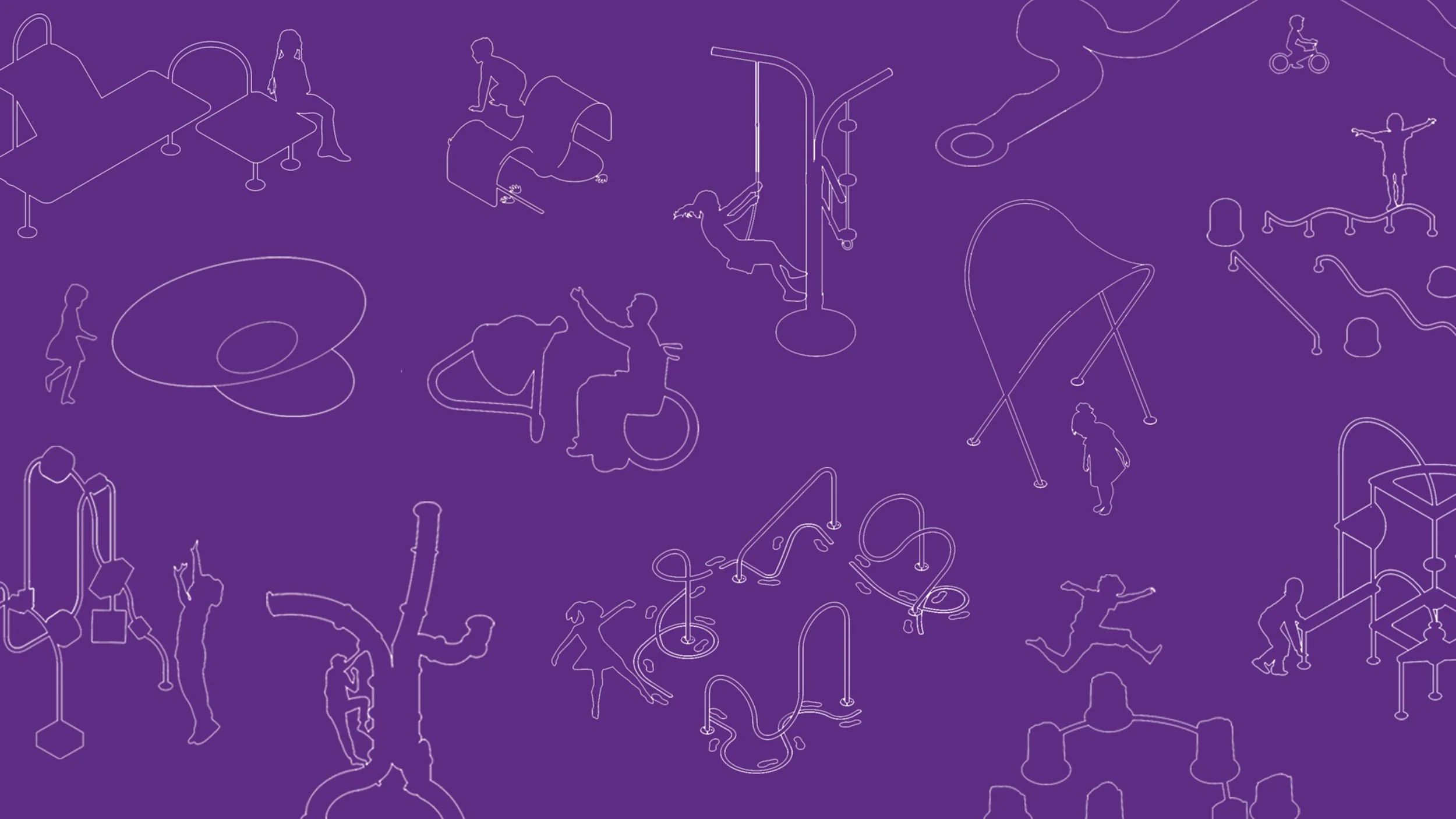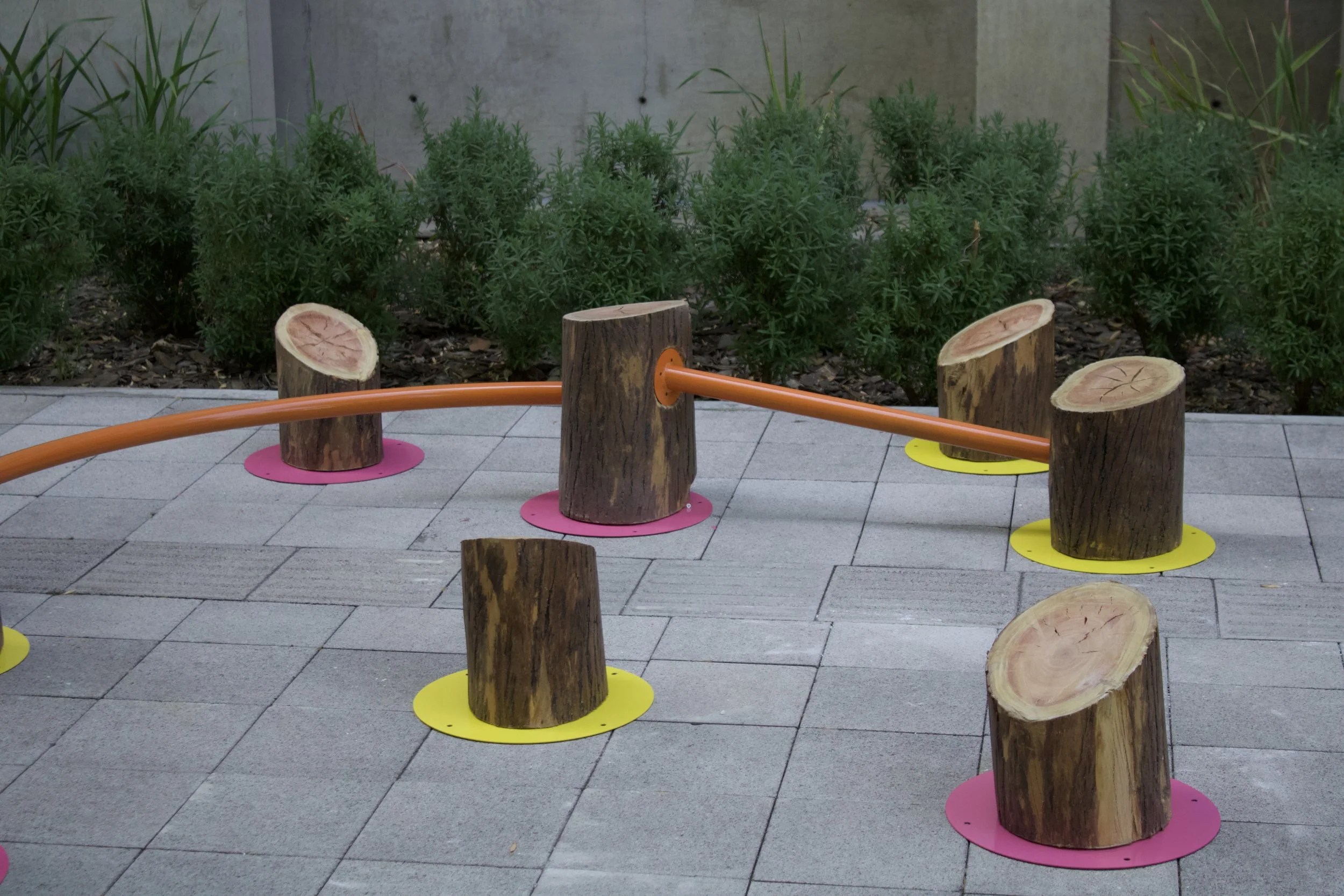THINKING AND CREATIVE PROCESS /SPECIFICATION OF
PRODUCTS AND SERVICES / DESIGN AND INNOVATION (CCM)
PROFESSORS: GERARDO OSIO, DANIEL ZURITA, MARCELO RAMÍREZ, HILDA VARELA, YURUEN LERMA, ROMAIN ROY-PINOT, ALBERTO MENDOZA, LUCERO DE LA HUERTA
CAMPO LÚDICO X LUDICALLES
Campo Lúdico (Recreational Field) is a set of 13 urban games developed in collaboration with Ludicalles. The urban furniture aims to meet the needs of the children in the town of Iztapalapa, Mexico City, and integrate optimally into their streets.
The proposals are an invitation to reclaim the streets as safe spaces for play; the students designed furniture with the intention of creating a playful and safe environment that encourages family and community interaction. Therefore, various meetings and workshops were organized among students, professors, coordinators, and children to determine the activities that guided the design of the urban games.
Each piece is designed from an action related to play.
ENTRELAZOS
Michelle Díaz, Ximena Monroy,
Juan Carlos Rodriguez
OUTSTANDING PROJECT
AT HORIZONTES 2024
TO PAINT
Painting transcends the paper, becoming an act of creation and expression. Entrelazos abstracts this into a 3D experience with movable beads and curved tubular structures.
The beads, with basic geometric shapes, evoke familiarity, while the tubes suggest fluid painting strokes. This design fosters creativity, motor, and cognitive development through various interactive possibilities, reflecting free play and encouraging exploration.
hOJA
Aremy Beltrán, Valeria Cárdenas,
Andrea Obaldía, Sebastián Valdespino
TO PROTECT FROM THE SUN
The activity involves physically shielding from sunlight to avoid UV exposure, burns, heatstroke, or excessive heat. In a playful context, it means creating shaded areas where children and caregivers can enjoy outdoor activities. This project, inspired by the butterfly roof, provides wide shade, diffuses light, dissipates heat, and distributes weight.
The structure is playful and functional, creating interactive play areas with dynamic partial shadows that encourage creativity and safe play. This project reinvents sun protection, transforming natural light into a tool for limitless imagination and creation.
nido
Valeria Romero, Ana Paulina Román,
Emylen Gutiérrez, Nelly Castillo
TO SIT
Strictly speaking, sitting refers to taking a resting position with the buttocks supported by a surface.
However, in the context of play, sitting goes beyond the action. It becomes a moment of connection, an opportunity for conversation, contemplation, learning about the surroundings, and creating new imaginations. The moments we share often happen while sitting, and these moments are made possible by the arrangement of the space.
lianas
Maria Beltrán, Diana Hernández,
Juan Pablo Islas, Sofía Roldán
TO SWING
Swinging involves pendular movement, providing sensations like air on the face, butterflies in the stomach, and adrenaline throughout the body. This game is based on a swing and a tree, but our proposal encourages children to swing freely, moving from one vine to another.
Nowadays, the art of spending hours playing in a park until sunset, taking risks, and having fun has been lost. This game aims to allow new generations to enjoy these experiences while developing social, physical, and motor skills that give them a sense of belonging and community.
SENDERO
René Aguilar, Aranza Gutiérrez,
Jihoon Moon, Regina Moxca
TO SKATE
Skating refers to the act of gliding over a surface using wheeled equipment. It provides both fun and stimulation for the motor skills of those who practice it.
ESCALÁRBOL
Fernando Cabrera, Vanessa de la Cueva, Paulina Ibarra, Jocelyn Vázquez
TO CLIMB
Climbing is the act of ascending using the body's limbs to move across a surface. It requires coordination, strength, dexterity, and motor skills, fostering physical and mental development.
This climbing structure considers factors such as ergonomics, safety, and appropriate challenge for users, ensuring a rewarding and stimulating experience. Surfaces and grips are strategically chosen to offer various difficulty levels and encourage continuous improvement of climbing skills.
LÍNEAS
María José García, Paulina Bessie,
Jesús Ordaz, Cristhian Robles
TO DANCE
Dancing is a rhythmic bodily expression to music, combining art, personal expression, communication, exercise, and social connection.
It allows deep emotions to be expressed beyond words, providing a sense of freedom and connection with music and surroundings. Using steel tubes to convey fluidity, this project invites children to explore and challenge their bodies with imaginative, unconventional movements.
OLA
Francisco Lantigua, Abraham Mereles, Luisa Salazar, Daniela Sánchez, Regina Reyes
TO SLIDE
Sliding refers to movement over a smooth or slippery surface, like moving stealthily or unnoticed, like a ninja, or an unexpected fall on a wet surface. This action involves various senses, reflecting fluidity and evoking a sensation of movement.
The goal is to create functional and safe furniture that provides children with a space where they can enjoy, learn, and grow safely and fun. Additionally, it aims to contribute to the physical, cognitive, and social development of children, promoting an inclusive play environment that inspires creativity and strengthens their emotional well-being.
constelación
Alexa Cuevas, Lucía López,
Alejandro López, Joana Pedroza
TO BALANCE
Balance, as a physical activity, is maintaining an upright, stable position using compensatory movements. It can be static, dynamic, or rebalancing. External factors like base width, height, and support stability can create challenges.
The project includes two parts: cement domes of varying heights for static balance, and curved steel tubes for dynamic balance and rebalancing. This approach improves body control in a playful and safe manner. Balance is crucial for physical and cognitive growth, enhancing coordination, concentration, and problem-solving skills.
CIMA
Sofía Castillo, María José Aurioles,
Suzan Avitoglu, Andrea Rivero
TO CLIMB
Climbing is ascending using the body intuitively. It is an action practiced daily, on both small and large scales, requiring gross motor coordination, balance, and strength. In return, it provides a sense of achievement, challenge, and fun.
Whether climbing, jumping, hanging, or even resting at the top, this piece offers a dynamic and exciting experience for children while promoting their physical and motor development. The varying levels turn a common activity into an exciting adventure, stimulating imagination and allowing each child to reach their own peak.
saltamontes
Sergio Mimendi, Sebastián Pacheco, Nathalia Segovia
TO JUMP
Jumping is a physical activity that involves propelling oneself from a surface into the air using the feet. It is used in various exercises and sports to improve strength and coordination, as well as in children's games for recreation.
Additionally, jumping can be an emotional reaction to surprise or joy. It is as natural as running or walking and differs from bouncing. Notably, jumping is the only activity involving complete suspension in the air, distinguishing it from other movements.
oruga
Johana Hernández, Abril Medina,
José Emiliano Rosillo
TO CRAWL
The human action of crawling refers to the act of moving on the ground using the entire body, particularly the hands and knees, interacting with any surface.
In the context of childhood and playful activities, crawling is a form of exploration and play that can be transformative and liberating, allowing children to interact directly and sensorially with their immediate environment. It becomes a safe and creative space that promotes motor development, curiosity, a sense of community, inclusion, and collaborative play.
trompa
Mariana Cano, José Manuel Maza,
Luna Ordóñez
TO LISTEN
Listening refers to the act of paying attention to sounds, words, or messages perceived through the sense of hearing.
In a playful context, listening becomes an interactive and creative experience. It involves more than just perceiving sounds; it includes actively participating in activities designed to stimulate auditory attention and promote effective communication. This can involve games, active listening exercises, storytelling, music, and any other means that engage the sense of hearing in a fun and educational way. Thus, listening becomes a tool for learning, communication, and creativity.























































